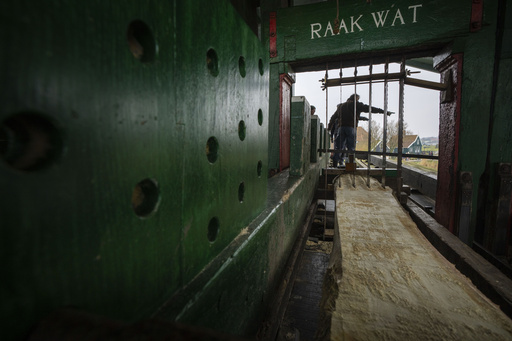
ZAANDIJK, Netherlands — A brisk winter breeze briefly raises hopes that the large sails of a historic windmill near Amsterdam might start to turn. On the mill’s cutting floor, six blades lift and lower, cutting through a wooden plank.
However, as the wind fades, the sails and saws come to a standstill.
“If the wind doesn’t blow, we’re out of a job,” remarked Erik d’Ailly, a 69-year-old volunteer miller.
Despite the unpredictable nature of their work, the traditional art of utilizing wind energy for tasks such as draining low-lying areas, sawing wood, and grinding grain is experiencing a revival in the Netherlands, a country renowned for its iconic windmills. Both Peter Booij and d’Ailly are among a record 110 newly certified millers. Booij, 68, proudly showcases his miller’s pin on his green fleece sweater, which offers warmth inside the mill.
Training to operate a windmill typically takes two to three years and largely consists of hands-on experiences followed by an examination. Most new graduates volunteer at windmills, which must remain operational to stay in good condition.
“It’s crucial to maintain the 1,200 mills that are still functioning today. A mill, much like a vehicle, requires regular operation to remain in good shape,” stated Nicole Bakker, director of De Hollandsche Molen, an organization dedicated to protecting the interests of windmills and their operators since 1923.
“The miller’s craft is recognized as part of UNESCO’s intangible heritage,” she added. “To safeguard this craft, we must also preserve the mills.”
For centuries, this low-lying country depended on windmills to help manage water from its marshy terrain and convert grain into flour. Windmills were also instrumental in processing wood used for shipbuilding and grinding spices brought from Dutch colonies around the globe.
Even with advanced technologies such as electric pumping systems, many traditional windmills still play a role in managing water during heavy rainfall.
Some of these mills also attract many visitors. The windmill where Booij and d’Ailly work is located in Zaanse Schans, a historic district near Amsterdam that draws crowds to explore its windmills, museums, and refurbished period homes.
The interest in mastering the craft of milling surged during the COVID-19 pandemic, as lockdowns led many to focus on local attractions. Bakker noted, “People began to notice mills in their neighborhoods and thought it might be fulfilling to become a miller.”
Booij’s journey into the world of windmills began with a small interest that blossomed over time. Initially working on a model of a mill built by his late father-in-law—also a miller—he eventually transitioned to real windmills. After two years of dedicated training, he passed his exam last year.
“You need to understand everything about operating the mill, but the weather is also vital,” he commented. “You must anticipate various weather conditions, especially wind patterns.” He also mentioned the dangers posed by thunderstorms due to the risk of lightning strikes.
Working at a windmill often sparks engaging conversations.
“Many people are unaware that this profession still operates and don’t realize that a mill requires a miller for its upkeep,” d’Ailly explained. “All Dutch citizens see these mills everywhere, yet they don’t realize what goes on inside, and this piques their curiosity.”

